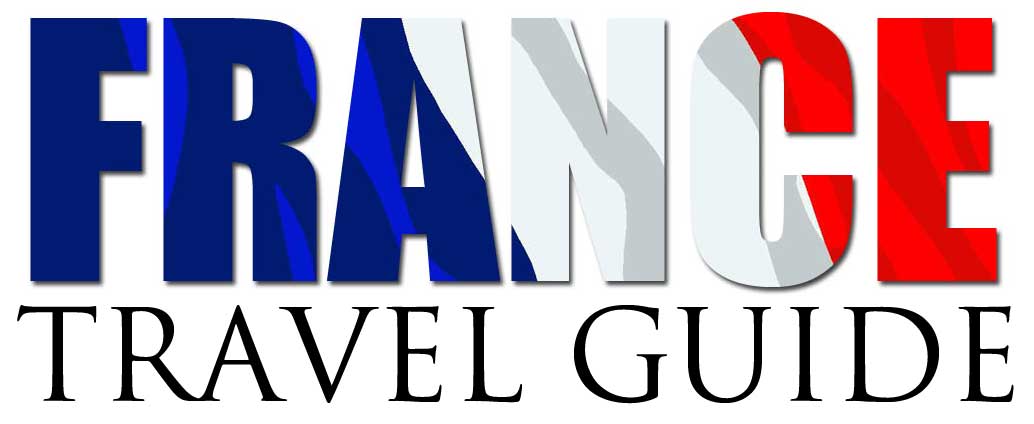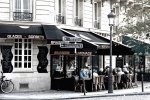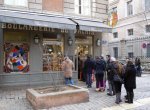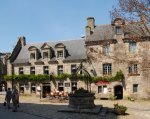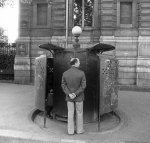FINISTèRE HIGHLIGHTS
Although accessible from the ferry port at Caen (Ouistreham), many visitors from Britain come to Brittany via Plymouth to Roscoff. Alas, the ferry terminal is a little away from the centre so there is a temptation to skip the town and head on east into the meat of Finistère.
Now,
Roscoff is never going to become one of the Top Ten destinations in France, but
it deserves better than that, and does have an attractive centre of granite
buildings, not least its impressive church, all of which relate the town’s long
links with the sea. There are narrow streets and plenty of restaurants and bars
in which to get that first taste of France, a taste very much centred on the
produce of the sea on which the local economy has long been heavily based.
|
It's hard to resist the appeal of Roscoff |
Roscoff has long been a key port, especially for trade with Britain, and it is hard to resist its appeal. It was from Roscoff that the iconoclastic ‘Johnnies’ with their black berets, bicycles and strings of onions set off from England, a business plan first put into action by Henri Ollivier in 1828, and which flourished for over a hundred years. Much earlier than this, Mary, Queen of Scots, landed here in 1548, en route to Paris to be engaged to the son of Henry II. So, too, did Bonnie Prince Charlie, in 1746, following his defeat at Culloden.
There are two principal towns to Finistère: Brest and Quimper. Brest, one of the finest natural harbours in Europe, is the larger of the two, and hastily (i.e. without architectural taste) rebuilt following devastation during the Second World War, which was intended to prevent the town from being used by Germans as a submarine base. Quimper, by contrast, amply demonstrates that less is more, for while there really is nothing wrong with Brest, it is among the cobbled streets of central Quimper, around the cathedral, that something of the old provincial way of life can still be sensed. Half-timbered houses (colombages) bring an air of antiquity to this town in a lovely little valley at the junction (kemper in the Breton language) of the rivers Steir and Odet.
Quimper is the capital of the ancient kingdom of Cornouaille, but the contemporary city has a very relaxed air about it, with bars and eateries aplenty, especially in the streets radiating from the cathedral. The cathedral itself is dedicated to Saint Corentin, one of the figures responsible for founding Brittany after the fall of the Roman Empire. Much of the interior decoration – furnishings, reliquaries and statues – was stripped away during the Revolution and the Reign of Terror (1793), and while the lime-washed interior that remains may not suit some tastes, it does leave the cathedral with a bright and appealing atmosphere.
Not far from Quimper, you encounter the village of Locronan, a community somewhat set in aspic, or at least firmly rooted in granite and times past. This used to be a major centre for woven linen, of the type required for sails by the French, Spanish and English navies.
Beyond Locronan lies the Crozon Peninsula, part of the 420,000-acre Parc Régional d’Armorique, a splendid, protected, natural landscape, stretching from the coast to the gentle hills inland. But before you get there it is worth diverting ever so slightly up to the top of a hill, Menez-Hom. You can drive to the top, and at a mere 330m, this rounded summit gives an extensive panorama across Finistère. To the north-west you can pick out the new bridge, the Pont de Térénez. Across the bridge lies Le Faou, a tiny medieval port with some 16th-century architecture still remaining, and its own estuary. For anyone heading for the Crozon Peninsula from Roscoff, then Le Faou is very much a gateway.
The peninsula is a place of craggy cliffs and golden sand beaches, windswept moorland and tiny coves, not least at Morgat a little to the south of the main town Crozon. The beach here is a gentle arc, backed by a scattering of brightly painted shops and bars, which provide everything you need for a short break or an uncomplicated, encore le pastis, life style. Continue down the peninsula and you come eventually to Cap de la Chèvre, the headland of the goats, a rather magnificent un-interfered-with setting overlooking the Bay of Douarnez, and around the very edge of which runs a superb coastal path that will delight even the most rudimentary of walkers.
Head off in a slightly different direction, and you run out of land at Camaret-sur-Mer, a dizzy little place favoured by artists, and with brightly coloured shop and restaurant fronts that would do Scotland’s Tobermory proud. All the restaurants specialise in seafood, which neatly satisfies the advice never to eat seafood more than five miles from the sea; in this case five strides are nearer the mark. Follow the harbour round and you come to the splendid Tour Vauban, a slightly plump, red-orange tower with no apparent purpose other than to occupy the end of the jetty, and built by the renowned master builder and military engineer of that name. Close by, the Chapelle-Notre-Dame de Rocamadour is a low-slung Breton church admirable as a piece of architecture, but like the adjacent tower seemingly in completely the wrong place.
|
Alignements Mégalithiques de Lagatjar, Crozon’s answer to the question that is Carnac |
Just before reaching Camaret, a little diversion takes you to the Alignements Mégalithiques de Lagatjar, Crozon’s answer to the question that is Carnac in Morbihan, though much less spectacular. There are no multiple rows of standing stones here, just two parallel lines joined by another, and with a few larger stones off at a respectable distance. In 1776, there were over 600 stones here, believed to have been erected 4,500 years ago. By 1883, there were fewer than a hundred remaining. General consensus is that the alignments are to do with astronomy, which seems to be the default explanation for anything prehistoric that no one really understands. Personally, I can’t help feeling that they resemble a large parking bay for an alien spaceship. Whatever; but their rough, lichenous surfaces are a fascination for school groups and the curious alike. There doesn’t have to be an answer to every question.
Recent Articles
-
French Food and Drink - No BS Guide for lovers of Food, Wine, Liqueurs
Aug 28, 19 03:18 AM
Our guide to French food and drink for those who love traditional French food along with our no BS guide to understanding French wine and liqueurs
-
Things To Do In Carcassonne The Ultimate Tourist Guide
Aug 24, 19 06:26 PM
The ultimate tourist guide to things to do in Carcassonne when you visit this wonderful town in Aude France. Discover the places to go and see in Carcassone.
-
Lyon Old Town Guide to Vieux Lyon
Aug 18, 19 07:48 AM
Your complete guide to Lyon old town otherwise known as the Vieux Lyon. Don't miss this amazing part of the city if you're visiting Lyon in France.
-
18 French Villages You Must Visit Most Beautiful Villages in France
Aug 17, 19 06:31 AM
Our guide to the 18 most beautiful French villages you simply must visit. Loads of info, photos and facts in our ultimate villages in France tourist guide
-
What a Pissoir - The True Story of France's Unique Urinals
Aug 13, 19 03:47 PM
Is there anything more French than a pissoir? Sadly on the decline nevertheless the pissor is an endring image of the country. This is their story
